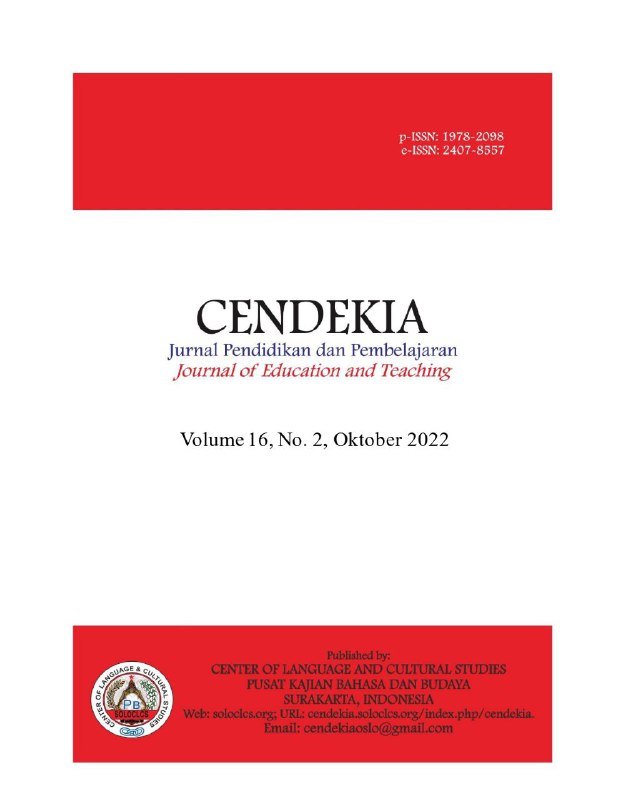Exploring Culinary Arts Vocational High School Student in Learning English Specialized Vocabulary
DOI:
https://doi.org/10.30957/cendekia.v16i2.675Keywords:
Vocabulary, Specialized Vocabulary, Semi-Structured InterviewAbstract
This study is planned to explore culinary arts vocational high school students experience in learning specialized vocabulary and their strategies to overcome the challenges both in the classroom and field job. This research conducted qualitative research as methodology and did an semi-structured interview with five Culinary Arts Student from SMK Paramitha 1. The interview in topic will ask the respondent about how they learn specialized vocabulary from any media and deepening about language-related issues, individual influences, and learning source the participants from actively learning with structured interview. More particularly, it is planned to understand the participants’ experience of learning vocabulary in (i) lectures/tutorials, and (ii) social contexts. This finding found that students find their own strategies and method in order to face their struggle in learning specialized vocabulary.
Keywords:
Downloads
References
Basturkmen, H. (2008). Ideas and Options in English for Specific Purposes. London: Lawrence Erlbaum Associates Publishers.
Braun, V., & Clarke, V. (2006). Using thematic analysis in psychology. Qualitative Research in Psychology, 77-101.
Chung, T. M. (2003). Technical Vocabulary in Specialised Texts. Reading in a Foreign Language Vol. 15, 103-116.
Clark, M. (2013). The Use of Technology to Support Vocabulary Development of English Language Learners. Education Masters.
Coxhead, A., & Nation, P. (2001). The Specialised Vocabulary of English for Academic Purposes. In J. Flowerdew, & M. Peacock, Research perspectives on English for Academic Purposes (pp. 252-267). Cambridge: Cambridge University Press.
Crocker, R. A., & Heigham, J. (2009). Qualitative Research in Applied Linguistics: A Practical Introduction. Hampshire: PALGRAVE MACMILLAN.
Garzone, G. (2017). Food, culture, language and translation. Journal of Multicultural Discourses, 214-221.
Lee, B. C., & Chern, C.-I. (2011). ESP Reading Literacy and Reader Identity: A Narrative Inquiry Into a Learner in Taiwan. Journal of Language, Identity & Education Vol. 10, 346-360.
Nation, P. (2001). Learning Vocabulary in Another Language. Wellington: Asian EFL Journal.
Nation, P. (2013). Learning vocabulary in another language (2nd ed.). Cambridge: Cambridge University Press.
Nordin, N. M., & Stapa, S. H. (2019). Productive use of specialized vocabulary in L2 culinary studies. Opción, Año 35, Especial No.19, 1351-1379.
Nordin, N. M., Stapa, S. H., & Darus, S. (2015). Are My Words Good Enough To Eat?: The Teaching and Learning of Specialized Vocabulary in Culinary Studies. Journal of Social and Humanities, 77-83.
Nordin, N. R., Stapa, S. H., & Darus, S. (2013). Developing a Specialized Vocabulary Word List in a Composition Culinary Course through Lectures Notes. Advance in Language and Literacy Studies, 78-88.
Park, J., Choi, N., Kiaer, J., & Seedhouse, P. (2019). Young Children’s L2 Vocabulary Learning through Cooking: The Case of Korean EFL Children. The Asian EFL Journal January 2019, Issue 21 Volume 1 , 110-131.
Priyono. (2011). LEXICAL ANALYSIS OF THE VERB COOK AND LEARNING VOCABULARY: A CORPUS STUDY . Language and Literature, P, Philology. Linguistics, P1-1091, 150-165.
Swales, J. M. (2004). Research Genres: Exploration and Application. Cambridge: Cambridge University Press.
Utomo, A. B., & Nurmasitah, S. (2017). SMARTPHONE APPLICATION FOR INCREASING ENGLISH CULINARY VOCABULARY. 3rd Asia Pacific Conference on Contemporary Research (APCCR- 2017), 92-100.
Downloads
Published
How to Cite
Issue
Section
License
Authors who publish with this journal agree to the following terms:
- Authors retain copyright and grant the journal right of first publication with the work simultaneously licensed under a Creative Commons Attribution-ShareAlike 4.0 International License that allows others to share the work with an acknowledgement of the work's authorship and initial publication in this journal.
- Authors are able to enter into separate, additional contractual arrangements for the non-exclusive distribution of the journal's published version of the work (e.g., post it to an institutional repository or publish it in a book), with an acknowledgement of its initial publication in this journal.
- Authors are permitted and encouraged to post their work online (e.g., in institutional repositories or on their website) prior to and during the submission process, as it can lead to productive exchanges, as well as earlier and greater citation of published work (See The Effect of Open Access).












